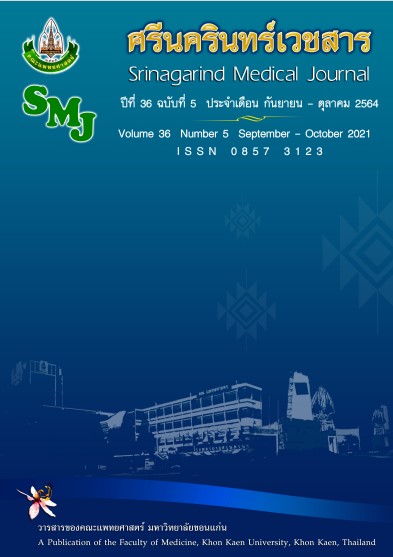Outcomes of Pharmaceutical Care by SMART AsthCOPD Application Program to Care Asthma Patients
Keywords:
Asthma; Pharmaceutical care; Computer application; SMART AsthCOPDAbstract
Background and objectives: Drug Related Problems (DRPs) lead to an increased rate of hospitalization due to asthma exacerbations. In the past, pharmacist provided pharmaceutical care using paper documentation which might lost and was not connected to an electronic medical record. Then, the SMART AsthCOPD application program was developed to solve those problems. The objectives of this study were to assess the impact of computer application on DRPs, assess the impact on the accuracy of patient technique for MDI use and the rate of hospitalization from asthma exacerbation before and after using the SMART AsthCOPD application program to care patients with asthma.
Methods: Patients aged 18 years or older with an asthma diagnosis, ICD-10 coded J45-J46 who were seen for three visits in an internal medicine adult asthma clinic and a pharmacy specialist clinic from October 1, 2016 to September 30, 2018 were included. Data of clinical outcomes were retrospectively collected from an electronic medical record from September 1, 2016 to October 31, 2018. McNemar’s test was used to compare the correctness of technique to use MDI, and hospitalization from asthma exacerbations.
Results: Of 497 patients, who were provided pharmaceutical care for three visits. The average age was 58.08 ± 15.25 years. The most commonly identified DRP in these patients was non-adherence. Incorrect MDI technique was seen in 44.7%. Most of them had no caregiver and use MDI without spacer. After the third pharmaceutical care, patients had proper MDI technique from 63.0% to 89.1% (p<0.001). The rate of emergency department visits and hospital admissions due to asthma exacerbation decreased from 15.3% to 5.6% and 6.2% to 3.4%, respectively (p<0.001, p<0.001).
Conclusion: Providing pharmaceutical care with using the computer application program significantly improves the proper technique to use MDI. Moreover, pharmacist can continuous follow-up patients with DRPs and the incidence of hospitalization due to disease exacerbation were decreased.
References
2. Easy Asthma/COPD Clinic. Khon Kaen University. [Assessed March 20, 2017] Available from: http://www.easyasthma.com.
3. Lertsinudom S, Boonsawat W, Samosorn C, Chanthawong S. Pharmacist’s Intervention on Managing Drug Related Problems in Easy Asthma Clinic, Srinagarind Hospital. IJPS 2008; 4(2): 13-23.
4. Rea HH, Scragg R, Jackson R. A case-control study of deaths from asthma. Thorax 1986; 41: 833-839.
5. Songmuang A, Songmuang T. Outcome of the inhalation technic monitoring card used in the pharmaceutical care provided to outpatients who used metered dose inhaler. TJHP 2016; 26(2): 71-80.
6. Lertsinudom S, Jinatongthai P. Development of Pharmaceutical Care Database Management Software for Asthmatic Patients in Order to Use Quality of Life Questionnaire in Routine Clinical Practice. IJPS 2011; 7(3): 55-60.
7. FitzGerald JM, Reddel H, Pedersen S, Becker A, de Jongste J, Lemanske R, et al. Global Strategy for Asthma Management and Prevention. Global Initiative for Asthma (GINA). 2014. [Assessed March 18, 2017] Available from: http//www.ginasthma.org.
8. สมพร จันทร์จรัสจิตต์. เภสัชกรรมในโลกที่เปลี่ยนแปลง: กลยุทธ์การพัฒนาวิชาชีพเภสัชกรรม. ศรีษะเกษ: สำนักพิมพ์พานทอง; 2558.
9. ธิดา นิงสานนท์, ฐิติมา ด้วงเงิน, วีรชัย ไชยจามร, และคณะ. แนวทางสำคัญสำหรับการบริบาลทางเภสัชกรรม (Essential Tools for Pharmaceutical Care): สมาคมเภสัชกรรมโรงพยาบาล (ประเทศไทย). กรุงเทพมหานคร: สำนักพิมพ์ประชาชน; 2558.
10. สุณี เลิศสินอุดม. บทบาทของเภสัชกรในการบริบาลผู้ป่วยโรคหืด. ใน: สุณี เลิศสินอุดม. การบริบาลผู้ป่วยโรคหืด โรคโพรงจมูกอักเสบ ภูมิแพ้ และโรคปอดอุดกั้นเรื้อรัง. พิมพ์ครั้งที่ 1. ขอนแก่น: โรงพิมพ์คลังนานาวิทยา, 2553: 73-85.
11. Songmuang T, Songmuang A. Pharmaceutical care monitoring in outpatients with drug related problems, before and after developing a computerized program. Proceeding of the 16th Asian Conference on Clinical Pharmacy; 2016 July 14-18; Seoul, Republic of Korea.
12. Jolly GP, Mohan A, Guleria R, Poulose R, George J. Evaluation of metered dose inhaler use technique and response to education training. Indian J Chest Dis Allied Sci 2015; 57: 17-20.
13. Ammari WG, Chrystyn H. Optimizing the inhalation flow and technique through metered dose inhalers of asthmatic adults and children attending a community pharmacy. J Asthma 2013; 50: 505-513.
14. Cochrane MG, Bala MV, Downs KE, et al. Inhaled corticosteroids for asthma therapy: patient compliance, devices, and inhalation technique. Chest 2000; 117: 542-550.
15. Alamoudi OS. Pitfalls of inhalation technique in chronic asthmatics. Effect of education program and correlation with peak expiratory flow. Saudi Med J 2003; 24: 1205-1209.
16. Tilly-Gratton A, Lamontagne A, Blais L, Bacon SL, Ernst P, Grad R, et al. Physician agreement regarding the expansion of pharmacist professional activities in the management of patients with asthma. Int J Pharm Pract 2017; 25(5): 335-342.
17. Mann A, Esse T, Abughosh SM, Serna O. Evaluating Pharmacist-Written Recommendations to Providers in a Medicare Advantage Plan: Factors Associated with Provider Acceptance. J Manag Care Spec Pharm 2016; 22(1): 49-55.
18. อรพรรณ โพชนุกูล. เคล็ดลับในการพิชิตโรคหืด. [เข้าถึงเมื่อ 23 กุมภาพันธ์ 2562] เข้าถึงจาก: http://www.tac.or.th/web/index.php/education/knowledgeforpeople-menu/170-knowledge-1.




